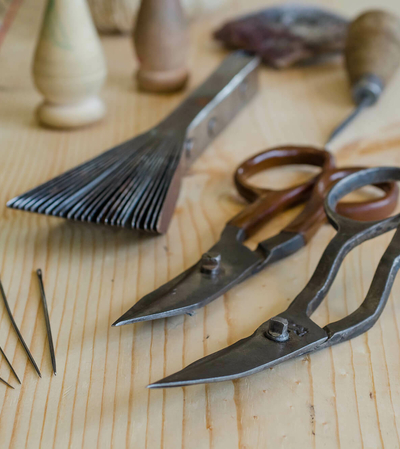For furnishings and fixtures, visit our sister company,
integral interiors 
The traditional rug making process has been established by generations of weavers for hundreds of years. In modern rug making, this process provides the structure to which we apply innovation and new eyes to cater to modern needs.



The final look of a rug is envisioned long before the weaving process begins. Rug designs can be inspired by any form of art such as drawing, painting, photo collage, or mixed media. A rug begins as a vision, gets fleshed out using traditional art processes, and finally becomes a computer rendering. Afterwards, rug sample swatches are produced to help us select the optimal weaving techniques and color ways to achieve the original vision.


The first step in the rug weaving process is to prepare the fiber materials and transform them from their natural state into yarn. Traditionally, wool is the most popular fiber used in making rugs. Wool yarn begins by months of growth on the backs of sheep. Once the wool is safely and gently sheared from the sheep, hand carding begins. The carding process involves hand combing the raw fibers between two paddles so that all the strands of wool lie in the same direction. The paddles have brush-like metal spikes on one side, acting like a brush to work out tangles and filter out any grasses or thorns from the terrain on which the sheep roam. After carding, the fiber is ready to be spun into yarn. Spinning is another hand process, often aided by a spinning wheel. The wool is fed into the wheel where it is twisted into a long strand of yarn. It is during this process where the thickness of the yarn can be varied depending on the desired ultimate look of the finished pieces. Once the yarn is spun, it is looped into skeins in preparation for the dye process.


Traditionally, Tibetan rugs were dyed with natural dyes. Dyers would forage for bark, berries, leaves, and flowers to extract pigment from. Since the invention of synthetic dyes in the 1850’s, modern rugs have been colored with chrome dyes. To dye the yarn, a dye pot called a vat is made by heating the dyestuff and water. The yarn skeins are placed into the large pot of dye and are constantly turned on a wheel to fully permeate the yarn. This way, the application of the dye is applied evenly to the skein. The yarn then dries naturally in the sun to create an added sheen and luster.

After a rug design is created and transformed into a CAD rendering, designers transform the design into a grid structure, where each square on the graph represents one knot on the rug. This graph is what instructs the weavers which colors to knot, one by one, to create the visual of the overall rug design.

Our rugs are woven on vertical structures called looms. These metal looms are dressed with cotton warps, the vertical strings of the rug which create the vast canvas on which the weavers tie the knots. Our looms come in all sizes, some are readily available and others have to be constructed specifically for each project, especially if the rug is oversized.

Hand-knotting is the main technique for our rug construction. Within the hand-knotting realm, there are many types of knots we use depending on the design, including Tibetan, Persian, Sumac & Turkish. Knots are woven one by one using the graph as a guide. This is the part of the process where the thickness of the rug is created, called the pile. Flat weave is another weaving style that uses flat wefts of yarn that weave over and under the warp, creating a thinner rug pile.

After the weaving process has finished, the rug is cut off the loom for washing. At this point, the rug undergoes an intense washing process where it is soaked with water. This aids the yarns in grabbing onto each other, and binds the fibers together as one textile. This part of the process also binds the dye to the yarn, and rinses away any pigments that have not been absorbed. Lastly, the washing process removes any dust or dirt that could have been embedded into the rug during weaving. The water is squeezed out of the rugs by using large flat tools to push the water out. This also creates a direction for the pile to lay, which results in the rug’s “shiny” side or “dark” side. After washing, the rug is stitched on to a metal frame and stretched out because the washing process creates some shrinkage. Here, the rug dries in the sun for several days.


After stretching and drying, the rug is removed from the frame so finishing can take place. In finishing, the rug may be shaved down to create an even pile, or clipped by hand with scissors to create a high low detail. Stray yarns are removed, and the ends of the rugs are bound with yarn to create a finished piece. When the finished rug is ready for shipment, it is carefully inspected for quality control before preparing for shipment.


Lastly, the rug has to be transported to its final destination. The international shipping process is often much more involved than meets the eye. Oftentimes, a rug travels on bike, then an Indian Tuk Tuk or truck, then it boards a small airline, and then a large airline to head to the States. The rug can take multiple flights before landing in America, when it is loaded onto another truck for its last leg of its trip to the Integral Thread Studio.